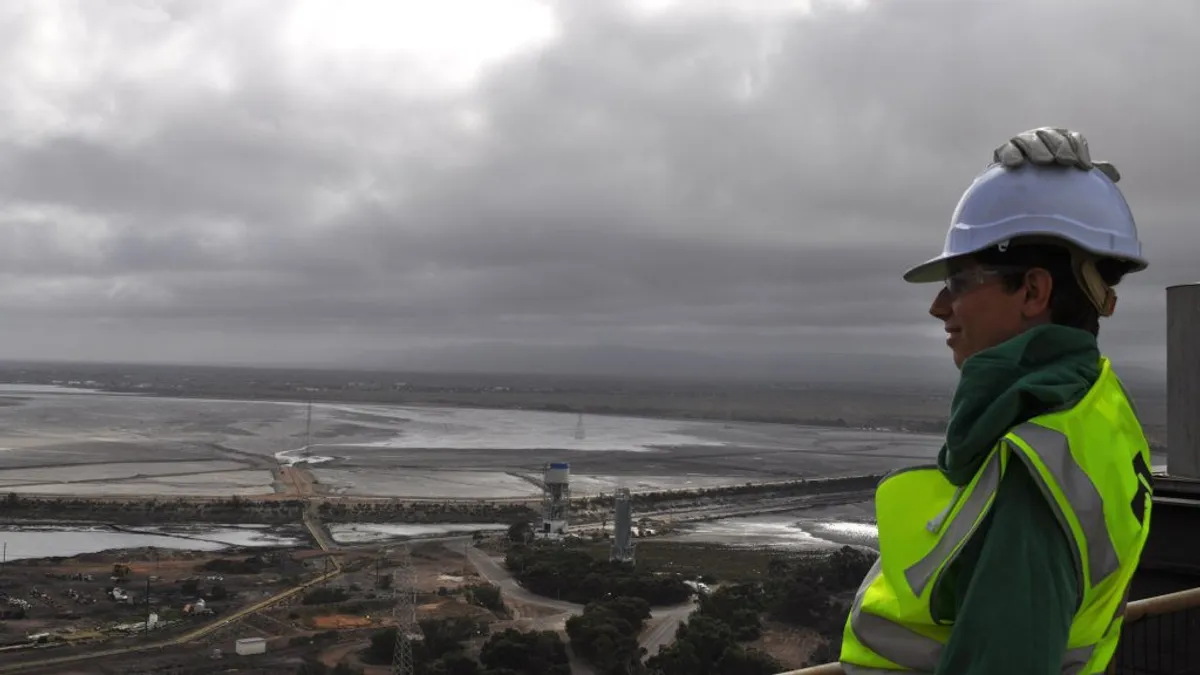Dive Brief:
-
More than 90% of coal plants that monitor groundwater pollution across the United States are leaking toxic coal ash pollution, according to a new national report based on industry disclosures.
-
Of 265 coal plants that report groundwater tests, 243 disclosed unsafe levels of at least one coal ash pollutant, including arsenic, lithium and other contaminants, according to the new report from the Environmental Integrity Project (EIP) and Earthjustice.
-
The data, representing about three-quarters of U.S. coal plants, come from utility filings mandated by federal coal ash rules that the Trump administration is attempting to roll back. The remaining plants were either exempt from reporting groundwater tests or were eligible for reporting extensions.
Dive Insight:
The EIP report is the first comprehensive analysis of utility groundwater filings mandated by the Obama-era Coal Combustion Residuals (CCR) rule. It reveals a widespread environmental and public health issue that affects "virtually all coal plants" that reported information to the EPA.
Researchers analyzed data from more than 4,600 groundwater monitoring wells around U.S. coal plants and ash disposal facilities. All told, 91% reported water pollution levels unsafe for human consumption "even after we set aside contamination that may be naturally occurring or coming from other sources," they wrote.
A majority of plants reported unsafe levels of arsenic, a carcinogen that can also impede brain development. More than 60% reported unsafe levels of lithium, which can also cause neurological problems. And most plants reported multiple contaminants, according to the researchers.
"The majority of coal plants have unsafe levels of at least four toxic constituents of coal ash," they wrote.
In some cases, pollution levels were "dramatically elevated." The report contains what researchers call the 10 worst cases of coal ash pollution in the U.S., including a Texas ranch contaminated with a dozen coal ash chemicals and a Maryland landfill only 19 miles from Washington.
"[A]t the Brandywine landfill in Prince George’s County, ash from three coal plants has contaminated groundwater with unsafe levels of at least eight pollutants, including lithium at more than 200 times above safe levels, and molybdenum (which can damage the kidney and liver) at more than 100 times higher than safe levels," researchers wrote of the Maryland facility.
Report authors caution that actual coal ash contamination is likely worse than their results reveal. The federal CCR rule did not cover ash facilities that closed prior to 2015, which researchers say also often leak contaminants into surrounding groundwater.
About a quarter of U.S. coal plants either fall under that exemption or have secured extensions for groundwater reporting under the CCR rule, according to the report. Those include generators owned by the Tennessee Valley Authority, which has pledged to post full groundwater tests this month.
Last week, TVA reported a new risk from one of those retired generators. At its Allen Fossil Plant, the utility identified a breach in a layer of clay that separates contaminated groundwater from a drinking water aquifer used by Memphis residents.
TVA told local media the arsenic present could have come from other sources, and that contaminated groundwater does not appear to be mixing with the drinking water aquifer. Report authors say federal authorities should do more to address the risk to drinking water.
"[T]here are numerous examples of residential wells or public supply wells rendered unsafe by coal ash, some of which we identify in this report," they wrote. "Yet the [CCR Rule] does not require the testing of drinking water wells near coal ash sites, so the scope of the threat is largely undefined."
Utilities across the nation say they are working with federal and state authorities to devise plans for coal ash cleanup, which can be costly. When TVA lost a 2017 legal case regarding coal ash at its Gallatin coal plant, it estimated the cost of moving the waste to a lined landfill at $2 billion before winning a temporary reprieve from an appeals court.
The fate of that cleanup plan remains in limbo. Last month, the Supreme Court decided to hear a Clean Water Act case that could have broad implications for how utilities store ash, and push them to move it to lined landfills.
The future of the federal CCR rule also remains unclear. The Trump administration in July moved to rewrite the Obama-era standards, giving utilities more time to report contamination and allowing states to set disposal requirements. The D.C. Circuit Court, however, ruled in August that the original 2015 rule was not protective enough, setting up an ongoing legal standoff.














